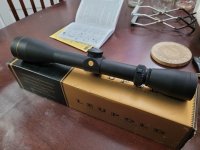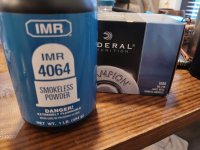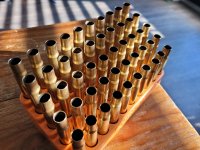RamblinWreck88
Useles Billy ain’t got nothing on ME !
I've mentioned in a few other threads that I recently picked up a CVA Scout in 35 Whelen, but this is really the first time I've set up a rifle for myself, not to mention the first time I have done any reloading, and it has been a great learning experience, so I wanted to continue that learning process by starting this thread... I intend this to be a living thread, and I freely admit that I have a lot to learn, so y'all please chime in if I'm doing something wrong or if there are any beginner reloading pitfalls I should be aware of. And pardon the dumb questions.
The idea was to have a rifle that I can carry all over the woods, in any conditions I'm willing to endure, through anything I'm willing to crawl through, from North GA to the Coastal Plain, and kill any critter in Georgia with authority, from any shot angle I feel comfortable with, and from any range I feel comfortable with, primarily sub-100 yards, but with the ability to reach out to ~200 yards, maybe more. And all of this should be as cost-effective as possible.
As bonuses, I love the simplicity and length-efficiency of a single shot, as well as the one-shot ethos. I also have been pretty impressed with 35-caliber cartridges. And I have been looking for an excuse to get into reloading. It turned out that the CVA's are of pretty good quality, with a pretty decent trigger. With that, I ordered the rifle and reloading equipment.
I originally thought I'd like to put a 2-7x on it, and was disappointed to have barely missed Midway USA's $200 deal on Leupold 2-7x's. But as I waited for the rifle to arrive, I found a new-old-stock VX-1 at 2014 prices + 15% discount, so I figured that 3-9x would work just fine:

After much delay, courtesy of FedEx, the rifle arrived:

As another bonus, the FFL surprised me by having large rifle primers, as well as IMR 4064. Evidently IMR 4064 is better suited for heavier .358 projectiles, but here we are:

Once the DNZ one-piece mounts arrived, I mounted the scope to my proper eye relief:

Yesterday, the rest of my reloading equipment came in (Lee hand press, pacesetter die set, shell length gauge, etc.). I have several brands of brass that has been put through my M1 rifle, but being new to this thing and not knowing what to expect, I decided to try out some PPU brass. I resized, decapped, and chamfered 50 pieces, which seemed to turn out pretty good (I think). I was absolutely giddy when I resized the first piece:

Next Steps:
1- Take some calipers to the brass and look for any obvious issues
2- Clean the brass up a bit more with the ol' Dawn & water method.
3- Prime enough brass for a range session
4- Charge brass starting at my manual's guide for 200-gr jacketed bullets, beginning with starting loads and working up. Loading 3 for each batch.
5- Seat bullet to specified OAL (TBD)
6- Go to the range and record data for each batch.
7- Rinse and repeat... The goal for now is to push a 200-gr Interlock SP a little below max for IMR 4064, a touch below 2560 fps, which is basically a .358 Winchester load. With that load as a foundation, I may work up another load based on what I learn.
Other Considerations:
-Length is still about shorter than a 30-06 w/ 22" even with 25" barrel on this one, and I am holding onto the option to shorten this barrel, depending on how I like it in the field and whatever else I learn.
-.358 projectiles are a bit limited in selection and my preference (225 gr PT) was unavailable everywhere I've seen. I'm continuing to explore options here, and I welcome suggestions.
Questions:
1- Is there any need to crimp my loads for a single shot in this intended role? I've read different things here and there... I am concerned with the effect crimping would have on the thinner neck of the resized '06 brass.
2- I'm really not sure how far to seat the bullet... I know I want to be right on the lands for a single shot, I just don't know how I get that length, though that's mostly because I haven't dug into it. I take it that I should nail down OAL before attempting to finalize powder charge? I want to isolate my variables and whatnot.
3- After I fire the starting load and verify that there are no pressure signs or other alarms, how much should I increase my next powder charge by?
The idea was to have a rifle that I can carry all over the woods, in any conditions I'm willing to endure, through anything I'm willing to crawl through, from North GA to the Coastal Plain, and kill any critter in Georgia with authority, from any shot angle I feel comfortable with, and from any range I feel comfortable with, primarily sub-100 yards, but with the ability to reach out to ~200 yards, maybe more. And all of this should be as cost-effective as possible.
As bonuses, I love the simplicity and length-efficiency of a single shot, as well as the one-shot ethos. I also have been pretty impressed with 35-caliber cartridges. And I have been looking for an excuse to get into reloading. It turned out that the CVA's are of pretty good quality, with a pretty decent trigger. With that, I ordered the rifle and reloading equipment.
I originally thought I'd like to put a 2-7x on it, and was disappointed to have barely missed Midway USA's $200 deal on Leupold 2-7x's. But as I waited for the rifle to arrive, I found a new-old-stock VX-1 at 2014 prices + 15% discount, so I figured that 3-9x would work just fine:

After much delay, courtesy of FedEx, the rifle arrived:

As another bonus, the FFL surprised me by having large rifle primers, as well as IMR 4064. Evidently IMR 4064 is better suited for heavier .358 projectiles, but here we are:

Once the DNZ one-piece mounts arrived, I mounted the scope to my proper eye relief:

Yesterday, the rest of my reloading equipment came in (Lee hand press, pacesetter die set, shell length gauge, etc.). I have several brands of brass that has been put through my M1 rifle, but being new to this thing and not knowing what to expect, I decided to try out some PPU brass. I resized, decapped, and chamfered 50 pieces, which seemed to turn out pretty good (I think). I was absolutely giddy when I resized the first piece:

Next Steps:
1- Take some calipers to the brass and look for any obvious issues
2- Clean the brass up a bit more with the ol' Dawn & water method.
3- Prime enough brass for a range session
4- Charge brass starting at my manual's guide for 200-gr jacketed bullets, beginning with starting loads and working up. Loading 3 for each batch.
5- Seat bullet to specified OAL (TBD)
6- Go to the range and record data for each batch.
7- Rinse and repeat... The goal for now is to push a 200-gr Interlock SP a little below max for IMR 4064, a touch below 2560 fps, which is basically a .358 Winchester load. With that load as a foundation, I may work up another load based on what I learn.
Other Considerations:
-Length is still about shorter than a 30-06 w/ 22" even with 25" barrel on this one, and I am holding onto the option to shorten this barrel, depending on how I like it in the field and whatever else I learn.
-.358 projectiles are a bit limited in selection and my preference (225 gr PT) was unavailable everywhere I've seen. I'm continuing to explore options here, and I welcome suggestions.
Questions:
2-
3- After I fire the starting load and verify that there are no pressure signs or other alarms, how much should I increase my next powder charge by?
Last edited:

